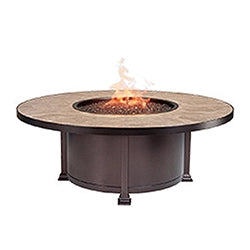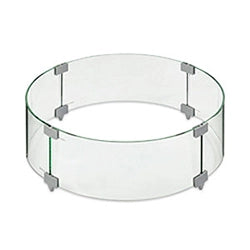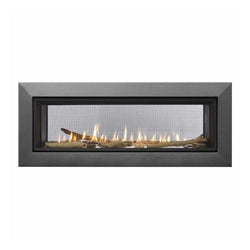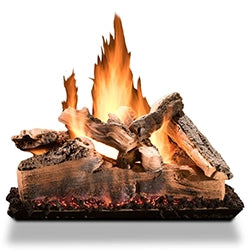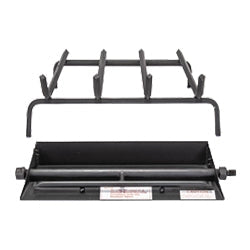Some fire pit accessories can seem unnecessary, but high-quality fire pit covers are not among them. I can’t tell you how many customers who’ve told me some version of this story… standing there, staring at their once-gleaming fire pit that now looked like it survived some kind of apocalypse. Rain-soaked, leaf-filled, and with that unfortunate “I’ve been neglected” rust around the edges. But their tragedy can be our tutorial, right?
So, today we’re coving all the most important outdoor fire pit cover information: benefits, types, materials, sizes, features… everything you need to know to choose the best cover for your patio fire pit.
The right cover doesn’t just extend your fire pit’s life—it can transform it from a seasonal luxury to a year-round focal point that’s always ready when you are. And let’s be honest—a fire pit should be your favorite backyard feature, not your most consistent source of buyer’s remorse.
Read our Comprehensive Fire Pit Buying Guide to learn everything you need to know to choose the right pit for your patio!
Fire Pit Cover Guide Quick Takeaways
- Material matters most: Polyester with a high denier rating (900+) outlasts vinyl in almost every climate, but you’ll pay more upfront
- Proper fit prevents problems: A cover that’s too loose will collect water and debris; too tight and it might tear at the seams
- Secure it or lose it: Without proper fastening, even the best cover becomes a sail in high winds
- Ventilation prevents moisture damage: Counter-intuitive but true—some airflow actually keeps your fire pit drier
- Regular cleaning extends cover life: A simple rinse every few months prevents UV degradation and material breakdown

Why Your Fire Pit Absolutely Needs a Cover
Let me share a quick story. Last summer, my neighbor Mike spent nearly $300 on a beautiful steel fire pit. “I don’t need a cover,” he told me. “It’s designed to handle fire—a little rain won’t hurt it.”
Six months later, I helped him load that same fire pit—now sporting impressive rust spots and water damage—into his truck… headed towards disposal.
Plus, protecting your patio living features helps boost your home's long-term home value. A fire pit cover is a great, low-cost, low-effort way to make that happen.
Here’s the truth: properly covering your fire pit can extend its lifespan by up to 40%. That’s not marketing hype—it’s the difference between replacing your fire pit next year or enjoying it for a decade. And according to Goodhousekeeping.com, "using a fire pit cover when your fire pit is not in use can help prevent accidental burns, keep children and pets safe, and reduce the risk of fire hazards from wind-blown embers."
About 76% of fire pit owners use covers, with good reason.
A quality cover protects against:
- Rain and snow that cause rusting and metal degradation
- Debris that clogs burners and airways
- UV rays that fade surfaces and break down materials
- Animals making homes in your cozy fire pit
- Moisture that promotes mold, mildew, and decay
I learned my lesson after my first uncovered fire pit developed rust spots faster than my teenager develops excuses for missing curfew. Now, covering my fire pit is as automatic as turning off the grill propane.
Types of Fire Pit Covers: Finding Your Perfect Match
Not all covers are created equal, and choosing the wrong one is almost as bad as having none at all. Here’s my breakdown of the main types you’ll encounter:
Standard Round and Square Covers
These are the workhorses of the cover world—designed to fit the most common fire pit shapes. They’re widely available and generally affordable ($50-100). Look for ones with reinforced corners if you have a square fire pit, as these areas tend to collect water and wear out first.
I once bought a round cover for my square fire pit thinking “close enough.” The corners stuck out unprotected, and naturally, that’s exactly where the rust began. Learn from my mistake: pick the right shape.
Custom-Fit Covers
 If you’ve invested in an unusual shape or a built-in fire pit, custom covers are worth every penny. They’re designed specifically for your dimensions, with no excess material to collect water or blow around in the wind.
If you’ve invested in an unusual shape or a built-in fire pit, custom covers are worth every penny. They’re designed specifically for your dimensions, with no excess material to collect water or blow around in the wind.Universal Covers
 The jack-of-all-trades option. These typically feature drawstrings or elastic hems to adapt to different shapes and sizes. They’re convenient and versatile, but rarely offer the perfect fit of a model-specific cover.
The jack-of-all-trades option. These typically feature drawstrings or elastic hems to adapt to different shapes and sizes. They’re convenient and versatile, but rarely offer the perfect fit of a model-specific cover.

Material Options: What Your Fire Pit Cover Should Be Made Of
Having tried nearly every material out there, I can tell you there’s a direct relationship between what your cover is made of and how long it will last.
Polyester: The Durability Champion
High-quality polyester (especially those with 600-900 denier ratings) offers exceptional water resistance and UV protection. It’s more expensive but typically lasts 3-5 years even in harsh conditions.
My current cover is a 900D polyester that’s survived three Minnesota winters without fading or tearing. Worth every penny of the $89.99 I paid.
Vinyl: Budget-Friendly Basic Protection
Vinyl covers are affordable and reasonably water-resistant, making them popular choices in the $40-60 range. However, they’re susceptible to cracking in cold temperatures and degrading under intense sun.
I’ve used vinyl covers in my more temperate previous home in Virginia, and they held up well for about two seasons before showing signs of wear.
Canvas: The Traditional Option
Canvas offers a classic look and good breathability, but without proper treatment, it can be susceptible to mold and mildew. Look for marine-grade canvas with waterproof coatings if you go this route.
My father-in-law swears by his canvas cover, but he also retreats it twice a year, which is more maintenance than I’m willing to commit to.
Heavy-Duty Tarp Material
These industrial-strength covers aren’t winning any beauty contests, but they’ll outlast almost anything on the market. They’re ideal for extreme climates with heavy snow or intense sun.
I use a tarp-material cover for winter storage—it’s not pretty, but it takes whatever Mother Nature throws at it.

Choosing the Right Size: Measurements Matter
If you find yourself asking, "Why isn't my fire pit lighting?" One thing to consider is the size of your cover. Getting the size right is critical—too small and it won’t protect properly; too large and it becomes a water-collecting pool on top of your fire pit. Here’s how to measure correctly:
- For round fire pits: Measure the diameter at the widest point, then add 2-3 inches for adequate coverage.
- For square/rectangular pits: Measure both length and width at the widest points, then add 2-3 inches to each dimension.
- For height: Measure from the ground to the highest point, and ensure your cover will reach at least 2/3 of the way down the legs.
I once eyeballed measurements for a cover and ended up with one that barely reached the edge of my fire pit bowl. The first rainstorm proved how useless that was when water simply ran off the cover and directly onto the fire pit base.
For my current setup, I measured twice (actually three times) before ordering, and the perfect fit has made all the difference in protection.
Features Worth Paying For in a Fire Pit Cover
After trying basic covers and deluxe models, I’ve identified the features that actually matter:
Secure Fastening Systems
Whether it’s drawstrings, elastic hems, buckled straps, or tie-downs, you need something to keep your cover in place during wind. Otherwise, you’ll find your cover in the neighbor’s yard after the first strong breeze.
I personally prefer covers with both elastic around the bottom AND buckled straps. Belt and suspenders approach, but it works.
Air Vents
This might seem counterintuitive—why put holes in something meant to keep water out? Because ventilation prevents condensation buildup underneath, which can cause as much damage as direct rain.
My current cover has mesh-protected vents, and I’ve noticed much less moisture under the cover compared to my previous vent-free model.

UV Protection
Look for covers specifically treated to resist sun damage, especially if your fire pit sits in direct sunlight. It's one of many patio must-haves if you want to protect your investment. UV-resistant covers might cost 20% more, but will last twice as long without becoming brittle or faded.
I learned this lesson the hard way with a cover that disintegrated after one summer in direct sunlight. Now I won’t consider anything without UV protection.
Reinforced Seams and Stress Points
Examine the stitching—double or triple seams last longer, especially at corners and edges where tension is greatest.
The difference between my budget cover that split at the seams after four months and my current cover with reinforced stitching has been night and day.
Padded Handles
A small detail that makes a big difference when you’re removing or replacing your cover regularly.
Trust me on this one—trying to wrestle a wet, heavy cover off your fire pit with tiny, flimsy handles is an exercise in frustration I don’t recommend.
Installing and Securing Your Fire Pit Cover Properly
Even the best cover fails if not installed correctly. Here’s my foolproof process:
- Clean your fire pit first: Remove debris, ashes, and ensure the surface is dry
- Wait for full cooling: Never cover a warm fire pit—wait at least 24 hours after use
- Center from the top: Start at the center and work outward, rather than from one side
- Secure all fasteners: Tighten drawstrings, snap all buckles, or tie all straps
- Check for proper drainage: Ensure the cover isn’t sagging in ways that will collect water
The first time I covered my fire pit, I rushed the job and didn’t center the cover properly. One side hung lower than the other, collected rainwater, and the weight eventually tore the cover’s edge. Taking an extra minute to position it correctly would have saved me from replacing it.

Care and Maintenance of Your Fire Pit Cover
A little maintenance goes a long way in extending your cover’s lifespan:
Regular Cleaning
Brush off debris weekly and clean thoroughly every 3-4 months:
- For fabric covers: Use mild soap and water with a soft brush
- For vinyl: Use a vinyl cleaner to prevent drying and cracking
- Always allow to dry completely before reusing or storing
I set a reminder in my phone for seasonal cleanings, and it’s made a noticeable difference in how long my covers last.
Proper Storage When Not In Use
During periods when your fire pit is in regular use, store the cover in a cool, dry place—not crumpled in a corner of the yard.
I installed a simple covered hook on the side of our shed specifically for hanging the fire pit cover when not in use. It takes up minimal space and prevents unnecessary wear.
Prompt Repairs
Small tears become big problems quickly. Keep a repair kit (patch material and waterproof adhesive) on hand for quick fixes.
A tiny hole in my previous cover became a 6-inch tear after one windy night. Now I check for damage regularly and patch immediately.

Seasonal Considerations for Your Fire Pit Cover
Different seasons bring different challenges for fire pit protection:
Summer Protection
Focus on UV resistance and ventilation. Remove the cover occasionally to prevent heat buildup that can damage both the cover and pit.
In summer, I take my cover off once a week even when not using the fire pit, just to let everything breathe.
Winter Readiness
In harsh winter climates, consider a winter-specific, heavy-duty cover with reinforced water resistance. Clear snow accumulation promptly to prevent weight damage.
After losing a cover (and nearly the fire pit itself) to the weight of collected snow, I’m religious about brushing off accumulation after each snowfall.
Spring and Fall Transitional Care
These seasons often bring the most variable conditions. Be vigilant about removing fallen leaves in autumn and pollen in spring.
I learned that wet leaves left on a cover can actually stain it permanently, so now I’m diligent about keeping it clear, especially during fall.
DIY vs. Store-Bought Fire Pit Covers: Pros and Cons
Should you make your own cover or buy one? Here’s my take on both options:
DIY Cover Benefits
- Custom fit for unusual shapes
- Material choice based on your specific needs
- Potential cost savings (sometimes)
- Satisfaction of creating something yourself
Store-Bought Cover Advantages
- Professional construction with reinforced seams
- Specifically designed features like vents and fasteners
- Warranties and guarantees
- Time-saving convenience
I tried the DIY route once with marine canvas and waterproofing spray. It looked decent and fit perfectly, but lacked proper ventilation and began to mold after a few months. For my next fire pit, I went with a professional cover and haven’t looked back.
However, if you have an unusual shape or custom build, DIY might be your best option. Just be sure to research proper materials and techniques.

Price Points: What to Expect at Different Budgets
Fire pit covers range dramatically in price. Here’s what your money typically buys:
Budget ($30-50)
- Basic protection from direct rain
- Typically vinyl or light polyester
- Minimal features, often just elastic edges
- 1-2 season lifespan
Mid-Range ($50-100)
- Better materials (higher denier polyester)
- Added features like ties or vents
- Better fit options
- 2-4 season durability
Premium ($100-200+)
- Heavy-duty materials with highest UV and water resistance
- Full feature set including reinforced stress points
- Custom sizing options
- 4+ year lifespan with proper care
I started with budget covers and worked my way up through frustration and replacement costs. Now I go straight for mid-range to premium options and consider it an investment in protecting my much more expensive fire pit.
Research shows about 65% of consumers prefer durable materials like heavy polyester for their covers, and I’ve joined that majority after learning the hard way.
Common Questions About Fire Pit Covers
How do I measure my fire pit for a cover?
Measure the widest point of your fire pit, then add 2-3 inches all around for adequate coverage. For height, ensure the cover reaches at least halfway down the base or legs.
Can I leave my fire pit cover on all the time?
While covers provide protection, I don’t recommend leaving them on continuously. Remove periodically (especially in hot weather) to prevent moisture buildup and allow airflow.
How do I secure my cover in high winds?
Look for covers with built-in straps, bungee cords at the base, or weighted edges. For additional security, consider aftermarket cover weights or tie-downs.
Are fire pit covers waterproof or just water-resistant?
Most covers advertise as waterproof, but in reality, most are highly water-resistant. True waterproofing requires sealed seams and specialized materials. Check if the cover uses terms like “600D polyester with PVC backing” for better water protection.
How do I clean and maintain my fire pit cover?
For most covers, gentle cleaning with mild soap and water is sufficient. Avoid harsh chemicals that can break down waterproof coatings. Always allow to dry completely before storage or reuse.
My Personal Recommendations
After years of trial and error, here are my tried-and-true recommendations:
For Standard Round Fire Pits
Look for 600D+ polyester covers with UV protection, ventilation, and secure tie-downs. Expect to pay $70-90 for quality that lasts 3+ years.
For Built-In or Custom Fire Pits
Custom-fit covers are worth the investment. Measure carefully and consider local manufacturers who can create exactly what you need.
For Areas with Extreme Weather
Choose covers specifically rated for your conditions—heavy-duty for snow regions, maximum UV protection for sunny climates, and reinforced fastening for windy areas.

A Final Word on Fire Pit Protection
Your fire pit isn’t just an outdoor accessory—it’s the heart of your outdoor living space, where memories are made and conversations flow. Protecting it properly isn’t just about preserving metal and mechanics; it’s about ensuring those moments continue season after season.
I’ve gone from being the guy who thought “it’s built to withstand fire, what’s a little rain going to do?” to someone who properly protects his investment. The difference has been night and day in terms of longevity, appearance, and functionality.
Remember: approximately 76% of fire pit owners use covers, and those who do properly protect their investment extend their fire pit’s lifespan by up to 40%. Join the smart majority—choose a quality cover, use it consistently, and maintain it properly.
Your future self (and your wallet) will thank you while you’re still gathering around the same beautiful fire pit years from now, long after the uncovered models have rusted away.







